An Argentine barbecue fiesta: Recipes for chorizo and steak sandwiches and Argentina's answer to chocolate ripple cake
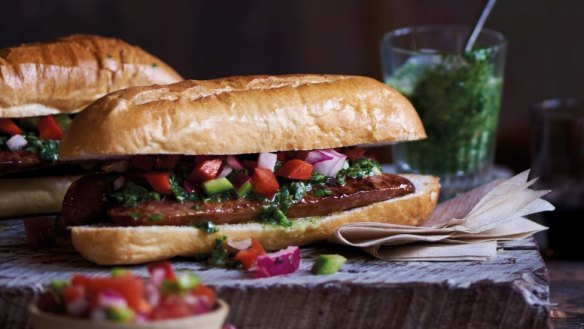
Bring some Argentine flavour to your next barbecue with chorizo-chimichurri rolls and steak sandwiches with the lot, and Argentina's version of the Aussie no-bake favourite – chocolate ripple cake – complete with homemade dulce de leche (milk caramel).
Choripan (chorizo roll with chimichurri and salsa criolla)
A street-food staple in Argentina is the 'choripan' or 'chori' as they are colloquially called – freshly cooked chorizo hot off the grill plate, served in crusty rolls with an array of condiments. A choripan stall will often sell an array of meat sandwiches including 'lomito completo' (see recipe below).
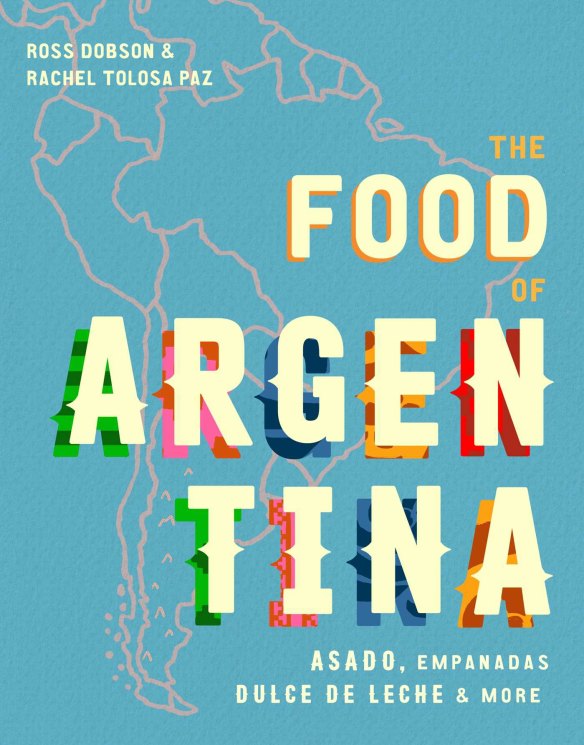
As for the chimichurri, you will be hard-pressed to find any two recipes the same. The ratio of herbs used is nearly always different and some may include chilli. Apple cider vinegar can be substituted with white or red wine vinegar or even a mild brown rice vinegar.
INGREDIENTS
4 fresh chorizos (about 200g) each
4 x 20cm long baguettes or bread rolls, sliced in half lengthwise
Chimichurri
1 bunch flat-leaf parsley, roughly chopped
1 bunch coriander, roughly chopped
1 tsp dried oregano
1 garlic clove, roughly chopped
2 tbsp olive oil
1 tbsp apple cider vinegar
sea salt and freshly ground black pepper
Salsa criolla
1 small red onion, diced
1 large tomato, seeds removed and diced
1 small red capsicum, diced
1 small green capsicum, diced
60 ml (¼ cup) extra virgin olive oil
2 tbsp apple cider vinegar
sea salt and freshly ground black pepper
METHOD
1. To make the chimichurri, place the ingredients in the bowl of a food processor and process until you have a well combined, thick green sauce. Season to taste, then transfer to an airtight container and set aside in the fridge.
2. To make the salsa criolla, combine the ingredients in a bowl and set aside for the flavours to infuse. This can be made several hours in advance and kept in the fridge, although it is best eaten on the day it is made. Season to taste, just before serving.
3. Preheat a barbecue grill or hotplate to high. Cut the chorizos in half lengthways and cook on the grill or hotplate for 4 to 5 minutes each side, until slightly charred.
4. Place the baguettes or rolls, cut side down, on the grill for 1 to 2 minutes to soak up the chorizo juices. Place a chorizo in each roll, then top with generous amounts of chimichurri and salsa criolla.
Serves 4
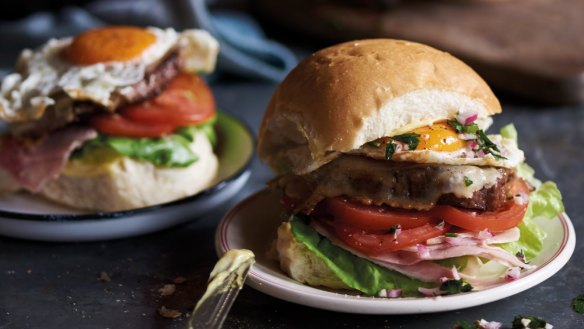
Lomito completo (steak sandwich)
This sandwich with the lot has it all: steak, lettuce, tomato and ham, finished off with a fried egg.
INGREDIENTS
2 garlic cloves, crushed
1 small red onion, finely chopped
2 tbsp finely chopped flat-leaf parsley
60ml (¼ cup) white vinegar
4 x rump steaks (about 200g each and no thicker than 1.5 cm)
2 tbsp olive oil
100g thinly sliced provolone cheese
4 eggs
mayonnaise, to spread
4 soft bread rolls, sliced in half
8 soft lettuce leaves
200g thinly sliced leg ham
2 large tomatoes, thinly sliced
METHOD
1. Combine the garlic, onion, parsley and vinegar in a bowl and set aside.
2. Place a large non-stick frying pan over high heat. Brush the steaks with 1 tablespoon of the oil and cook for 4 minutes on each side for medium rare, or a little longer if you prefer your steak more well done. Top the steaks with the provolone, then remove from the pan and cover to keep warm.
3. Wipe the pan clean and add the remaining oil. Fry the eggs to your liking and transfer to a plate.
4. To assemble the sandwich, spread mayonnaise on the cut sides of the bread rolls. Arrange the lettuce, ham and tomato on the bottom half of each roll. Place the steaks on top followed by the fried eggs. Spoon over some of the onion mixture and serve immediately.
Serves 4
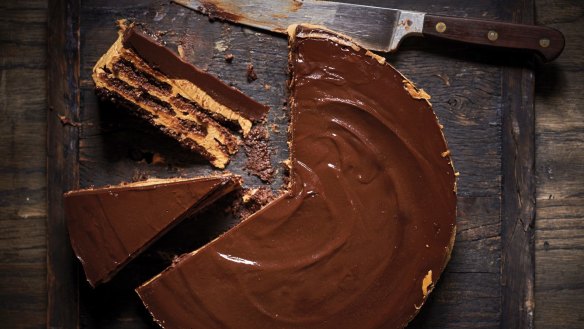
Chocotorta (Chocolate cake)
'Chocotorta' is a common birthday cake in Argentina. The name is a portmanteau of the Spanish words for chocolate and cake, but it also refers to the particular brand of Argentine chocolate biscuits – 'Chocolinas' – which are used to make it. This 'no-bake cake' takes a bit of time and care in assembling, and for best results it really needs a good overnight rest in the fridge for everything to settle down.
INGREDIENTS
butter, for greasing
500g cream cheese
500g dulce de leche caramel (store-bought or make your own; see recipe below)
1 tbsp unsweetened cocoa powder
250ml (1 cup) full-cream milk
400g Chocolinas or plain uncoated chocolate biscuits
Ganache
200ml thick cream
400g dark chocolate (at least 70 per cent cocoa solids), broken into small pieces
METHOD
1. Lightly grease a 22cm springform cake tin and line the base and side with baking paper.
2. Place the cream cheese and dulce de leche in a bowl and use electric beaters to beat until well combined. Set aside.
3. Whisk the cocoa powder and milk in a bowl, until the cocoa is dissolved. Dip one-third of the biscuits in the cocoa milk for just a few seconds, then transfer to the base of the prepared tin.
4. Spread one-third of the dulce de leche mixture over the biscuits, then repeat with two more layers of dipped biscuits and dulce de leche. Set aside in the fridge.
5. To make the ganache, place the cream in a saucepan over medium heat. When the cream is warm, but not boiling, remove from the heat and add the chocolate but do not mix or beat. Set aside for 10 minutes, then gently stir until smooth and glossy. Pour the ganache over the chocotorta and return to the fridge for at least 6 hours or overnight to set.
6. Remove the chocotorta from the tin and gently remove the baking paper. To serve, warm a knife in hot water, then dry, and cut the cake into thick slices.
Serves 12
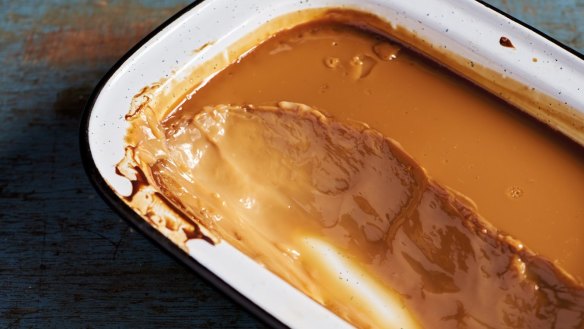
Dulce de leche, two ways
Dulce de leche is eaten with almost everything in Argentina. It's spread on toast for breakfast, used to fill pastries and 'alfajores', eaten alongside flans, pancakes and cakes, and is a ubiquitous flavour for ice-cream, but at its most basic you can enjoy it with a spoon straight from the jar!
The milk is the most important ingredient in dulce de leche and the fresher it is, the better the end result. If you can source raw milk (unpasteurised and still containing all the essential fats and cream), you will be rewarded.
Stovetop dulce de leche
Dulce de leche is traditionally made on the stovetop in Argentina. It is a labour of love that must be watched at all times. As odd as this may sound, not all stovetops are alike. If the lowest setting on your stovetop isn't low enough, you may have to use a heat diffuser to avoid the mixture from catching and burning. Constant stirring towards the end of cooking will produce a thick and rich coffee-coloured dulce de leche.
INGREDIENTS
1 litre full-cream milk
300g granulated sugar
¼ tsp bicarbonate of soda
pinch of salt
METHOD
1. Heat the ingredients in a heavy-based saucepan over high heat. Just before the mixture comes to the boil, reduce the heat to very low, ensuring that the mixture maintains a very gentle simmer (you may need to adjust the heat accordingly). Cook, stirring often, for about 1 hour, in which time the mixture will darken and thicken. From this point, stir the mixture frequently to avoid it catching and burning. Continue stirring for 20 to 30 minutes, until the mixture is thick and toffee-coloured.
2. To test if the dulce de leche is ready, place a spoonful on a cold saucer or plate. Allow it to cool and thicken, then run your finger through the centre of the dulce de leche. If the mixture doesn't pool back, it is ready. Transfer to a bowl and allow to cool completely.
Makes 410g
Oven-baked dulce de leche
The cheat's version, oven-baked dulce de leche requires only one ingredient and it is more convenient to make. Cooking a tin of condensed milk in a hot water bath maintains a constant temperature and allows the milk to caramelise and thicken to that distinctive texture and colour.
INGREDIENTS
2 x 395g tins sweetened condensed milk
METHOD
1. Preheat the oven to 180C.
2. Pour the condensed milk into a 1 litre baking dish and cover with foil. Sit the baking dish in a larger dish and pour enough boiling water to come half way up the sides of the dish with the condensed milk. Cook in the oven, topping up with boiling water to maintain the level, for 2 hours, or until the condensed milk is toffee-coloured (the top will be darker).
3. Carefully remove from the oven and stir to combine while still warm. Set aside to cool completely.
4. Transfer the dulce de leche to a very clean and dry glass jar. It will keep in the fridge for 2 to 3 weeks.
Makes 550g
This is an edited extract from The Food of Argentina: Asado, empanadas, dulce de leche and more by Ross Dobson and Rachel Tolosa Paz, published by Smith Street Books, $49.99; photography © Rachel Tolosa Paz, food styling Vanessa Austin.
The best recipes from Australia's leading chefs straight to your inbox.
Sign up